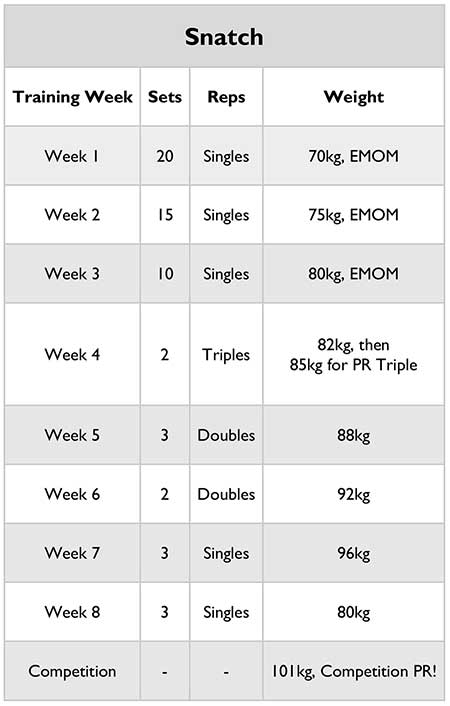An Excerpt from American Weightlifting by Glenn Pendlay
with James McDermott and Mike Prevost
A note from StrongFirst: Although the author is speaking of the Olympic barbell lifts, “timed sets” can be successfully applied to the deadlift and some other lifts.
I got the idea for timed sets from Louie Simmons of Westside Barbell, who uses sets of one or two reps with a brief rest between sets for the powerlifters he coaches. As a former powerlifter, I used to talk to Louie often, and this was one of the ideas he suggested. I used it in the 1990s with the back squat, and had success improving my strength. Later, when I converted to weightlifting, I tried it on the snatch and found the idea actually worked better for the Olympic lifts than it did for the power lifts. After I used timed sets for several years, I discovered Joe Mills used something similar at the Central Falls Weightlifting Club in Rhode Island many decades prior.
Around 2005, when I first wrote blog posts explaining how they were done, several respected weightlifting coaches said it was a ridiculous idea to do another set before completely recovering from the prior set. Oddly, one of those people now uses them extensively in his online training programs.
In the current age of CrossFit, timed sets have gained popularity because they pair weightlifting with oxygen debt, two things CrossFitters love. But most CrossFit athletes don’t know that a loose form of the idea was first used by Joe Mills in the 1960s, and an exact form of the Every Minute on the Minute workout (EMOM) was used in Texas in the 1990s—timed-set training predates CrossFit by decades.
This simple method can be used for both the snatch and the clean and jerk. The most basic example of a timed or EMOM set and what I originally used involves performing snatch singles EMOM for 10 minutes with 70% of a snatch 1RM. That will be a good starting point for many lifters. Most people can eventually use 75 or 80%, and some can go as high as 85%. With higher percentages, especially with clean and jerks, there’s value in expanding the rest from 60 to 90 seconds.
Benefits of Timed Sets
Timed sets work because they allow fatigue to gradually accumulate. During a normal set with just a few seconds of rest between repetitions, the first rep will typically be the easiest, the smoothest, and done with the best technique. As fatigue builds, subsequent reps will generally become sloppier, and usually the last rep of a set is both the most difficult and technically the worst. But during a timed or EMOM set, the athlete has nearly a minute of rest between repetitions. It’s not quite enough for full recovery, but enough to ensure that additional fatigue accumulates gradually. This difference in the rate at which fatigue accumulates is why timed or EMOM sets work so well.
It’s overwhelming when fatigue accumulates too quickly. When watching someone do a conventional set of three snatches, the buildup of fatigue and deterioration in technique over the three reps is usually very apparent. But if it accumulates slowly enough, athletes adjust and find a way to make lifts in spite of it.
During an EMOM set, the changes happen gradually. Pulling strength fades throughout the set, but other aspects slowly improve. During a timed set, you’ll find yourself moving a little faster, going under the bar a little deeper, and hesitating a little less as the set progresses. Timed or EMOM sets are a wonderful way to ingrain more efficient technique because they actually improve technique during the set and during the workout.
Every single rep is a first rep, and that’s another benefit of this method. Each repetition requires that you approach the bar, lower yourself into position, grasp the bar, and lift—the elements of competition attempts. The first reps are always a little different from subsequent reps, even if just mentally.
Like anything else, you get good at what you practice: Timed sets provide a lot of practice on first reps.
Programming Timed Sets
Timed sets are a technique every lifter should experiment with at some point. My only caution is to gradually acclimate to the training style, as it can provide a deceptively intense training session.
No single lift ever feels maximal, but if this type of training is done with too high a percentage of maximum or too many lifts per session, you can burn out and go backward. To avoid this, start with 70% once a week for both the snatch and the clean and jerk. You can do them both on the same day, but this makes for a very difficult training session. Make sure to use another method for the other training sessions during the week.
A repeating cycle is another idea I got from Louie Simmons. In this, a beginner might do 15 lifts with 70% the first week, then the next week 12 lifts with 75%, then nine lifts with 80% the third week. I’ve had lifters with good work capacity work up to 24 lifts with 70%, then 18 lifts with 75%, and finally, 12 lifts with 80% on the third week. I certainly wouldn’t attempt that on your first cycle using timed sets; however, as your work capacity builds, you may be able to use 75, 80, and 85% intensities for a rotating cycle.
I’ve had the most success with timed sets when lifting from the floor, but it’s worth trying from different positions.
Here’s an example of a training cycle starting with timed sets done once per week with the snatch. The lifter is assumed to have a max of 100 kilos. Week one will use 70% of the 1RM snatch. Week two will use 75% 1RM, and week three will use 80% 1RM.
Be creative and experiment with different ways of using timed sets, such as using them for one lift while using more conventional methods for another. Just remember that your goal is to increase the competition lifts at the end of each cycle. With that goal in mind, timed sets have but one weakness—you usually can’t approach maximal weights while doing them. That’s primarily the reason to use this method at the start of a training cycle, and then switch to more conventional methods of training as the cycle progresses.

CLICK HERE
# # #







Nice article. Judging from the rest periods, does this pack on size along with neural adaptations?
I have used this approach with sets of 10 kettlebell swings. My “escape valve” is that if I feel I’m getting too fatigued to continue, I add an extra minute’s rest before continuing with the remainder of the planned volume.
One can progress this way. E.g., if you start with 10 sets of 10 swings and find you need an extra minute’s rest after your 6th set, the following week you might try taking the extra rest only after your 7th set, and so on until you no longer need the extra rest.
I love heavy EMOM sets and have used them for more than a decade with a variety of exercises with great results and short sessions!
They can definitely be used with bodyweight and kettlebell exercises as well.